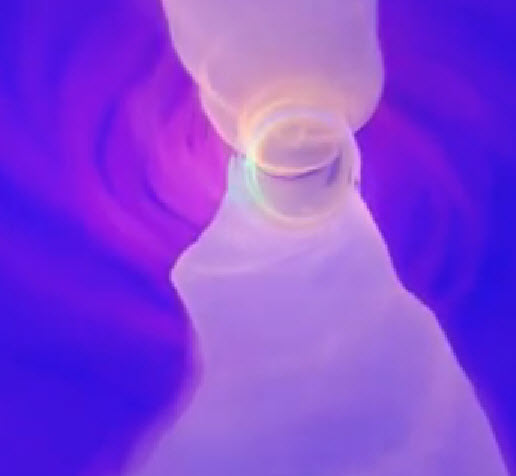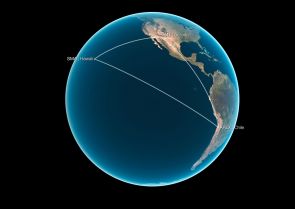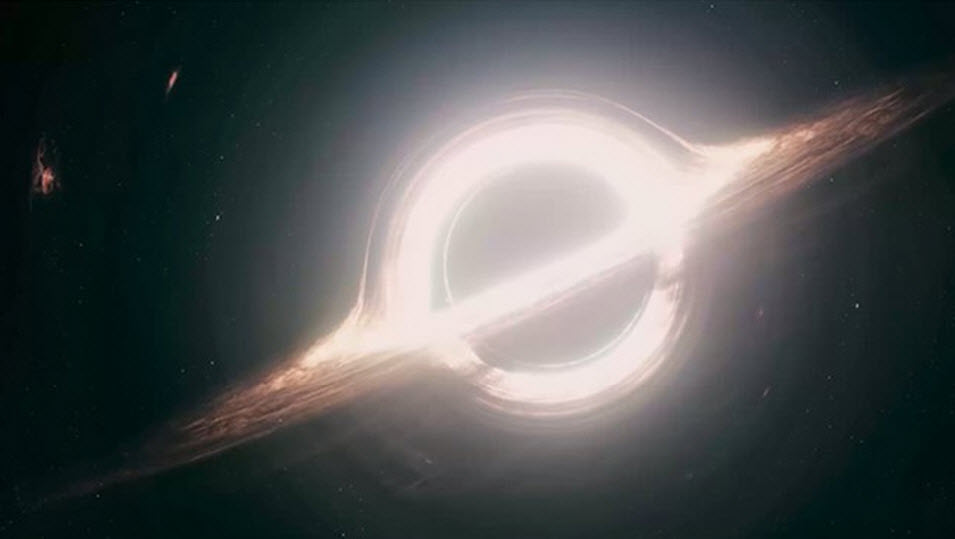Beyond Interstellar: new visualizations of the event horizon of black holes
November 10, 2014

Visualization of plasma around a black hole (credit: UA)
University of Arizona (UA) astrophysicists are taking the special effects in the movie Interstellar a step further, generating what happens when matter flowing into a black hole crosses the event horizon, the point of no return, and then disappears.
To do that, the astrophysicists are using UA’s new supercomputer — nicknamed El Gato — combining knowledge from mathematical equations and astronomical observations to generate visualizations of an object known by astronomers as Sagittarius A* (“Sagittarius A star”), a supermassive black hole comprising the mass of 4.3 million suns. It is located 26,000 light-years from Earth at the center of our galaxy.
The team just published visualizations of what a space traveler might see upon approaching SgrA* in two reports in the Astrophysical Journal — one focusing on imaging and the other on computing — providing some of the groundwork for the Event Horizon Telescope, or EHT, a huge undertaking involving scientists and observatories around the world to take the first-ever picture of SgrA*.
For the film Interstellar, a special-effects team of about 30 experts reportedly spent up up to 100 hours running calculations to create each frame. “Our team of four here at the UA can produce visuals of a black hole that are more scientifically accurate in a few seconds,” said Feryal Ozel, a UA associate professor of astronomy and physics.
“It’s a bit like gaming on steroids,” she explained. “El Gato uses a massively parallel architecture of hundreds of graphic processors working side by side, with each node functioning as a renderer in real time,” based on algorithms capable of calculating the paths of millions of individual photons in mere seconds as they shoot toward the black hole.
A telescope the size of the Earth

Observations of unprecedented resolution of plasma around black holes will be achieved by connecting radio telescope sites to make one large, virtual telescope (credit: ESO)
Funded by the National Science Foundation and NASA, the computer simulations are a crucial step before astronomers can start to look for the black hole using the EHT, functioning as a sort of field ID guide of what astronomers should look for once the EHT is up and running.
The EHT will combine radio telescopes across the globe to create a virtual telescope the size of the Earth. These include the UA’s Arizona Radio Observatory as well as the South Pole Telescope, outfitted with new receivers built by a group led by UA assistant professor of astronomy Daniel Marrone.
Visualizations
“We wouldn’t be able to observe a black hole against a black sky,” Ozel said. “Therefore, we look for other telltale signatures telling us about the presence of a black hole.” The gravitational field around a black hole is so immense that it swallows everything in its reach. Not even light can escape its grip.

Black hole visualization used in the movie Interstellar, based on a model by astrophysicist Kip Thorne (credit: Warner Bros. Pictures International )
As matter comes under the black hole’s spell of extreme gravity, a cosmic traffic jam ensues, in which gas swirls around it like water circling a drain. As matter compresses, the resulting friction turns it into plasma heated to a billion degrees or more, causing it to “glow” — radiate energy that astronomers can detect here on Earth.
“Our visualizations show there is a place where photons linger and form a ring outlining the shadow of the black hole,” said Dimitrios Psaltis, a UA professor of astronomy and physics. “These simulations also help us find ways to distinguish this signature from all this swirling plasma around the black hole.”
By imaging the glow of matter swirling around the black hole before it goes over the edge and plunges into the abyss of space and time, scientists can see only the outline of the black hole, also called its shadow.
In addition to providing groundwork for the EHT, the simulations will support NICER, a new NASA mission involving an instrument that will be attached to the International Space Station, to help scientists better understand neutron stars and to test navigation methods for future spacecraft using neutron stars as extremely accurate clocks.
The University of Arizona | Black holes
